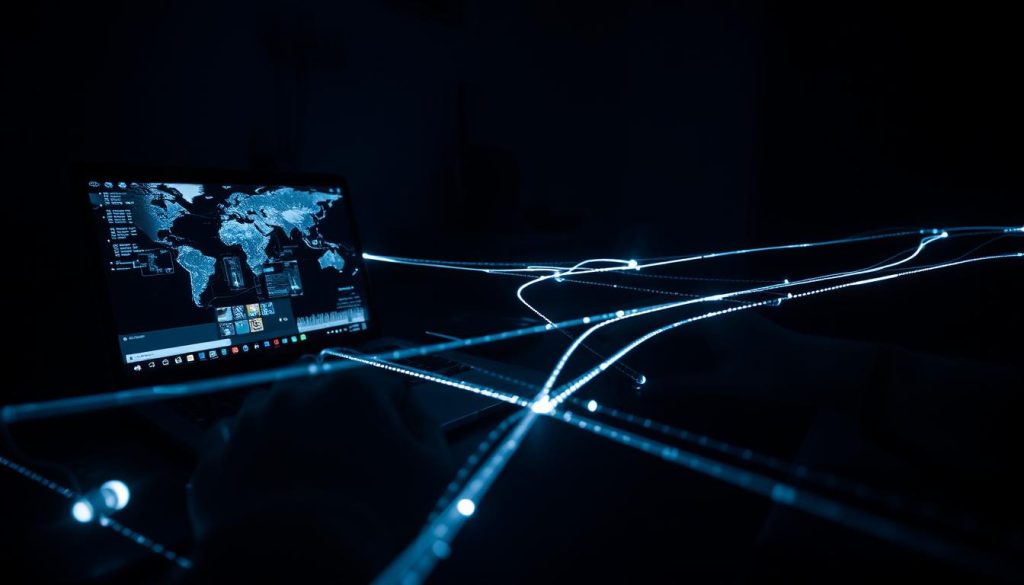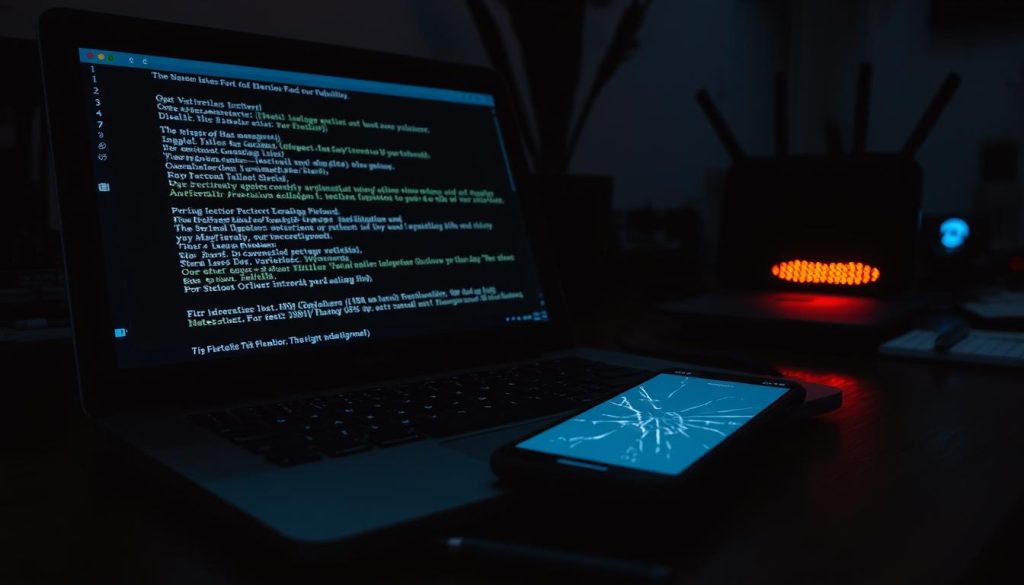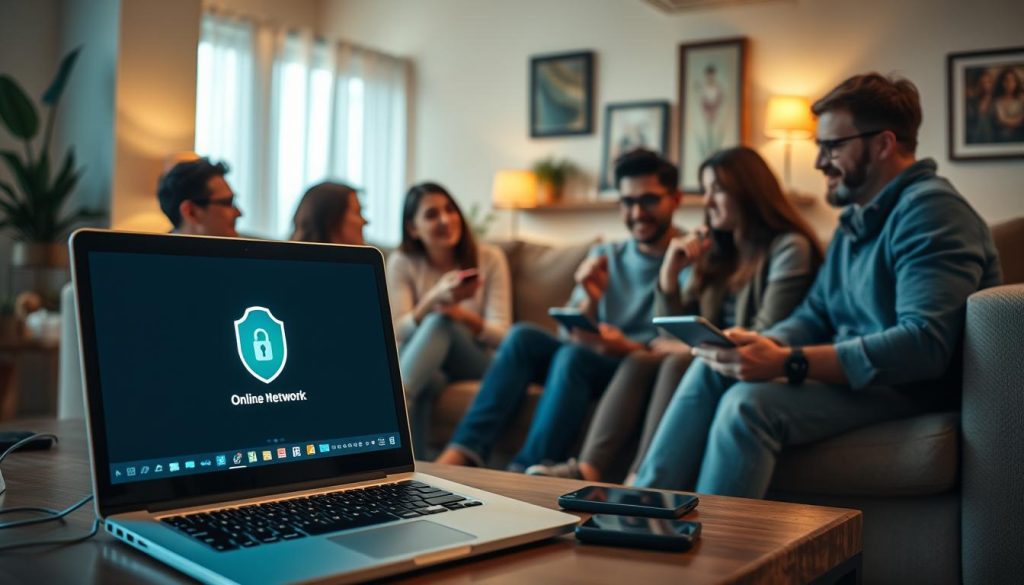In today’s digital world, your smart devices are a big part of your life. But, they also come with a risk. Mobile devices share your location information by default.
The U.S. National Security Agency (NSA) has a guide to help you reduce the risk of sharing sensitive info. This info can show where you go, when, and who you meet.
Key Takeaways
- Know how your mobile devices share location info.
- Follow NSA tips to lower the risk of sharing location data.
- Take steps to keep your location data safe.
- Understand the dangers of location data leaks.
- Protect your personal info and keep your privacy.
Understanding Location Data Leaks
Location data leaks from smart devices are a big worry. It’s key to know where they come from and why they matter for your privacy.
What Are Location Data Leaks?
Location data leaks happen when your location info gets shared without your okay. This can occur in many ways, putting your privacy at risk.
Common Sources of Data Leaks
Location data leaks often come from GPS, Wi-Fi, and Bluetooth. These techs help smart devices work but can also share your location.
Let’s look at how each tech contributes to leaks:
| Technology | How It’s Used | Risk Level |
|---|---|---|
| GPS | Provides precise location data | High |
| Wi-Fi | Used for network connections and location tracking | Medium |
| Bluetooth | Enables device-to-device communication and proximity tracking | Medium |
Why Location Data Is Valuable
Location data is valuable because it shows where you’ve been and what you do. This info can be used for ads or even worse.
Protecting your location data is key to keeping your privacy and security online. Knowing how leaks happen and where they come from helps you stay safe.
The Risks of Location Data Exposure
When your location data gets out, it can harm your privacy, safety, and money. With more smart devices, the chance of data leaks grows. It’s key to know the dangers.
Privacy Concerns
One big risk is privacy breaches. If someone gets your location data without permission, they can track you. They might even find out where you live or work. This can put your safety at risk.
To avoid these problems, limit who can see your location. Check the permissions of your apps and devices often. This can help keep your data safe.
Safety Implications
Location data leaks can also be dangerous. If the wrong people get your location, they might harm you or your family. Stalkers or criminals could track you, making you unsafe.
Financial Trajectories
Also, leaked location data can cost you money. Hackers might use it for identity theft or fraud. Knowing where you are often could let thieves target you.
| Risk Category | Description | Potential Consequences |
|---|---|---|
| Privacy Concerns | Unauthorized access to location data | Tracking, monitoring, identity theft |
| Safety Implications | Malicious use of location information | Stalking, physical harm, harassment |
| Financial Trajectories | Exploitation for financial gain | Identity theft, financial fraud, loss |
Knowing these risks is the first step to protect yourself. By understanding how your location data can be used, you can take steps to keep it safe. This can greatly reduce the chance of these bad things happening.
How Smart Devices Collect Location Data
Smart devices like phones, watches, and fitness trackers collect location data. They use different methods to find and share your location.
GPS Technology Explained
GPS is a key way smart devices get location data. It uses satellites orbiting Earth to send signals. These signals help devices figure out where they are, how fast they’re moving, and the time.
GPS technology provides high accuracy. It’s important for finding your way, tracking fitness, and using location-based services.
Wi-Fi and Bluetooth Tracking
Smart devices also use Wi-Fi and Bluetooth to find their location. Wi-Fi helps by detecting nearby access points. Bluetooth Low Energy (BLE) beacons track proximity to specific spots.
This method is especially useful indoors where GPS signals are weak.
Mobile Network Data
Mobile network data is another way devices get location info. It looks at signal strength and cell tower identities. This helps estimate a device’s location, especially in cities with lots of cell towers.
| Technology | Method of Locationing | Accuracy |
|---|---|---|
| GPS | Satellite signal triangulation | High |
| Wi-Fi | Detection of nearby access points | Medium |
| Bluetooth | Proximity to BLE beacons | Low to Medium |
| Mobile Network | Cell tower signal analysis | Low to Medium |
Knowing how devices collect location data helps with data privacy. By understanding these methods, you can better control your location data sharing.
Real-World Examples of Location Data Leaks
Our use of smart devices is increasing, which raises the risk of location data leaks. Many real-world examples show this. These incidents not only harm our privacy but also show the need for strong security to keep our data safe.
Case Study: Popular Fitness Apps
Fitness apps like Strava and Fitbit have faced location data leak issues. For example, Strava’s heatmap feature showed the locations of military bases and other secret areas around the world. This was not what the app was meant for.

This shows how important it is to control how we share our data. We must also know how apps use our location information.
High-Profile Breaches in Tech Companies
Big tech companies have also struggled with keeping location data safe. A major breach at a well-known tech firm exposed the location data of millions. This could have put users’ safety and privacy at risk.
| Company | Type of Breach | Impact |
|---|---|---|
| Tech Firm A | Location data exposure | Millions of users affected |
| Fitness App B | Insecure data storage | User location data accessible to unauthorized parties |
Incidents Involving Smart Home Devices
Smart home devices, like voice assistants and smart thermostats, have also been involved in location data leaks. These devices collect location data for services, but if not secure, this data can be stolen.
Protecting your location data needs a few steps. Be careful with app permissions, check your device’s privacy settings often, and stay alert to security threats.
Legal Regulations Surrounding Data Protection
Data protection laws are changing fast. New rules are coming to keep user data safe. As tech gets better and more personal info is shared, governments are making laws stricter to protect people.
Overview of GDPR and CCPA
The General Data Protection Regulation (GDPR) and the California Consumer Privacy Act (CCPA) are key laws. The GDPR in the European Union sets a high standard for data protection. It gives people control over their data and can fine companies a lot if they don’t follow the rules.
The CCPA in California, USA, also protects data. It lets people know what data is being collected, access it, and ask companies to delete it. Both laws affect companies worldwide that deal with data from EU and California residents.
Implications for U.S. Companies
U.S. companies face big challenges from these laws, especially if they work globally or deal with data from EU or California. They must follow strict data protection rules. This includes being clear about data collection, improving security, and letting people use their data rights.
If they don’t follow the rules, they could face huge fines and damage to their reputation. For example, GDPR can fine up to €20 million or 4% of a company’s global income, whichever is more.
| Regulation | Key Provisions | Implications for Non-Compliance |
|---|---|---|
| GDPR | Data protection by design, consumer rights to access and erase data | Fines up to €20 million or 4% global turnover |
| CCPA | Consumer rights to know, access, and delete personal data | Fines up to $7,500 per intentional violation |
Accountability and Consumer Rights
GDPR and CCPA focus on accountability and consumer rights. Companies must show they follow the rules. This includes doing data protection impact assessments and having data protection officers.
People have rights like the right to see their data, correct it, and ask for it to be erased. Using these rights helps people control their data and makes sure companies use it responsibly.
Recognizing Vulnerabilities in Your Devices
Knowing the weak spots in your devices is key to stopping location data leaks. Your smart devices, like phones, tablets, and smart home gadgets, share data. This makes them vulnerable at many points.
Key Features to Monitor
To shield your location data, watch certain features on your devices. These include:
- Location services: Check which apps use your location and adjust their access.
- Bluetooth and Wi-Fi: Turn off these when not in use to block unauthorized access.
- App permissions: Often check the permissions of your apps and remove any you don’t need.

Identifying Risky Apps
Some apps are more likely to risk your location data. Look for these signs:
- Apps that ask for too many permissions, like your location, contacts, or camera.
- Apps with bad reviews or are unknown.
- Apps that haven’t been updated or supported by their creators.
Importance of Regular Updates
Keeping your devices and apps current is vital to avoid location data leaks. Updates bring security fixes and protect against new dangers.
| Update Type | Description | Benefits |
|---|---|---|
| Security Patches | Fix known vulnerabilities in the system or apps. | Protects against known threats and vulnerabilities. |
| Feature Updates | Add new features or improve existing ones. | Enhances user experience and may include security improvements. |
| System Updates | Update the operating system of your device. | Often includes security patches and improves overall system security. |
By keeping an eye on your device features, spotting risky apps, and updating regularly, you can lower the chance of location data leaks.
Best Practices to Limit Location Data Exposure
To keep your location data safe, it’s key to follow best practices. Being proactive can greatly lower the chance of your location data being leaked or used wrongly.
Turning Off Location Services
One easy way to protect your location data is to turn off location services when not needed. Many devices and apps need location data to work, but you don’t have to keep location services on all the time.
Steps to Turn Off Location Services:
- On Android devices, go to Settings > Location, and toggle off.
- On iOS devices, navigate to Settings > Privacy > Location Services, and toggle off.
Adjusting Device Privacy Settings
Changing your device’s privacy settings can also help. Check your devices and apps’ privacy settings to make sure they are set to the most private options.
| Device/App | Setting to Adjust | Action |
|---|---|---|
| Smartphone | Location Services | Toggle off when not in use |
| Social Media Apps | Location Sharing | Limit to when the app is in use |
| Browser | Location Access | Block or ask for permission |
Using Virtual Private Networks (VPNs)
VPNs add extra protection by hiding your IP address. They are especially useful on public Wi-Fi networks, as they encrypt your internet traffic.
When picking a VPN, choose one with a strong no-logs policy. Also, pick one based in a country with good data protection laws. This keeps your data private and not shared with others.
Choosing the Right Smart Devices
To keep your location data safe, pick smart devices with good security. You need to think about a few things. This ensures you get a device that meets your needs and keeps your privacy safe.
Researching Manufacturer Privacy Policies
Before buying a smart device, check the manufacturer’s privacy policies. It’s important to know how they handle your data. Look for companies that are open about their data practices.
Key aspects to look for in privacy policies include:
- Data collection practices: What data is collected, and how is it used?
- Data sharing: Is your data shared with third parties, and if so, under what circumstances?
- Data protection: What measures are in place to protect your data from unauthorized access?
Opting for Devices with Strong Security Features
Devices with good security features help protect your location data. When picking a smart device, look for these security features:
| Security Feature | Description | Benefit |
|---|---|---|
| Encryption | Data is encoded to prevent unauthorized access. | Protects your data from being intercepted and read by unauthorized parties. |
| Regular Software Updates | Ensures the device stays protected against new vulnerabilities. | Keeps your device secure by patching known vulnerabilities. |
| Two-Factor Authentication | Adds an extra layer of security to the login process. | Makes it harder for attackers to gain access to your device. |
Consumer Reviews and Recommendations
Consumer reviews and recommendations offer insights into smart devices. Look for reviews from trusted sources. Pay attention to comments on the device’s security and customer support.
When reading reviews, consider the following:
- Overall satisfaction: Are users generally happy with the device?
- Security concerns: Have users reported any security issues or vulnerabilities?
- Customer support: How responsive is the manufacturer to user concerns and issues?

By researching privacy policies, choosing devices with strong security, and reading reviews, you can make smart choices. This helps protect your location data.
The Role of Software Updates in Security
Keeping your devices updated is key to security. Software updates often include fixes for new security issues. They help protect your devices from threats.
Importance of Staying Updated
Staying current is crucial for device safety. Regular updates fix bugs, boost performance, and close security gaps. This keeps your devices safe from harm.
How Manufacturers Issue Updates
Manufacturers send out updates to fix new problems and boost security. These updates come through different ways. You can get them by downloading from the manufacturer’s site or through your device’s auto-update feature.
Tips for Automatic Updates
Enable automatic updates to get the latest security fixes easily. Here’s how:
- Look in your device settings for the auto-update option.
- Make sure your device is online to get updates.
- Check your update history to see if updates are working.
| Update Type | Description | Benefits |
|---|---|---|
| Security Patches | Fixes for known security vulnerabilities | Protects against known threats |
| Feature Updates | Adds new features or improves existing ones | Enhances user experience |
| Performance Updates | Improves device performance and stability | Better overall device performance |
By updating your devices and using auto-updates, you boost their security. This protects your data and keeps your smart devices safe.
Educating Friends and Family on Privacy
When you take steps to protect your location data, it’s key to teach others too. This way, you help create a space where everyone values privacy. They’ll also learn how to keep it safe.
Starting the Conversation
Start by talking about location data privacy with your loved ones. Explain how devices collect and share your location. Share examples of why being careful is important.
Tips for Starting the Conversation:
- Choose a comfy spot where everyone feels at ease.
- Speak clearly and simply about complex topics.
- Be ready to answer questions and keep the conversation going.
Sharing Resources for Awareness
To teach your friends and family more, share trustworthy sources on location data privacy. This could be articles, videos, or guides from reliable places.
Some recommended resources include:
- Articles from trusted privacy groups.
- Webinars or workshops on digital privacy.
- Privacy guides from device makers.

Guiding Safer Practices
After they’re informed, show them how to be safer. This means changing device settings, using privacy apps, and being careful online.
Practical Steps to Safer Practices:
- Check and tweak privacy settings on their devices.
- Make strong, unique passwords for all accounts.
- Keep devices and apps updated for better security.
Teaching your friends and family about privacy helps keep them safe. It also helps build a culture where everyone values privacy. This collective effort makes the digital world safer for all.
Monitoring Location Data as a User
You can manage your location data by using different tools. It’s key to be proactive about your location info. This way, you can lower the chance of data leaks and keep your privacy safe.
Tools for Tracking Data Use
There are many tools to track your location data use. These include:
- Device Settings: Most smartphones and smart devices let you control location data access through their settings menus.
- Third-Party Apps: Apps like LocationGuard and Privacy Monitor give detailed insights into your location data use.
- Browser Extensions: Some browser extensions can track and block unauthorized location data collection.
Recognizing Anomalies in Data Sharing
To monitor your location data well, you need to spot data sharing oddities. This means:
- Regularly Checking Data Logs: Watch your devices or third-party apps’ data logs for any odd activity.
- Understanding Normal Data Usage Patterns: Know how your location data is usually used. This makes spotting odd uses easier.
- Being Cautious with Unusual Requests: Be careful of any location data requests that seem odd or unauthorized.
Reporting Concerns
If you find any odd activity or data sharing issues, report them. You can:
- Contact the App or Service Provider: Talk to the app or service’s customer support if you think they’re misusing your location data.
- Report to Regulatory Authorities: If the data misuse is serious, report it to the right data protection authorities.
- Adjust Your Settings: Change your device settings or app permissions right away to stop more unauthorized data access.
By following these steps, you can better control your location data. This helps make the digital world safer for everyone.
Future of Location Data Privacy
Technology keeps getting better, making location data privacy more complex. How we use smart devices and the data they gather is changing. It’s important to know what will shape the future of keeping our location data safe.
Emerging Technologies and Their Impact
New tech like the Internet of Things (IoT) and artificial intelligence (AI) are part of our lives now. These techs could greatly affect our location data privacy. For example, IoT devices can gather lots of location data, making detailed profiles of people. It’s crucial to think about how these technologies affect our privacy.
Shifts in User Awareness and Behavior
As people learn more about data privacy, their actions and what they expect are changing. They’re taking steps to control their data, like using VPNs and adjusting device settings. This change in how users act will likely lead to new ways companies handle location data.
Anticipating Changes in Legislation
Worldwide, governments are looking closer at data privacy laws. New rules, like the GDPR in Europe and the CCPA in the U.S., are being made to protect data. Companies will have to adjust to these new laws, making sure they follow the changing rules.
The future of location data privacy will be influenced by tech advancements, changes in how we act, and new laws. Keeping up with these changes is key to protecting your location data.
Conclusion: Empowering Yourself Against Data Leaks
Location data leaks from smart devices are a big privacy and security risk. Knowing how these devices collect and share your data helps you protect yourself. You can take steps to reduce your exposure.
Proactive Measures
First, check your device settings and adjust your privacy options to share less data. Use tools like Virtual Private Networks (VPNs) to boost your online safety.
Fostering a Privacy-Conscious Culture
Teach your friends and family about data privacy’s importance. Encourage them to protect their data too. A privacy-focused culture can lower the risks of location data leaks.
Staying Ahead
Keep up with new tech and privacy laws. This knowledge helps you update your strategies to protect your location data. You’ll stay ahead of data leaks.

